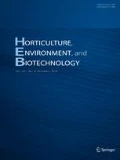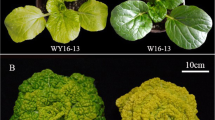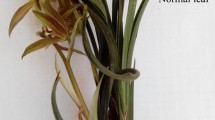Abstract
Paphiopedilum pacific shamrock is an orchid with high ornamental value. Understanding the mechanisms responsible for leaf color in albino mutants is important for ornamental development and breeding. In this study, we compared the leaf photosynthetic pigment content and transcriptome of albino mutants ppa01 and wild-type P. pacific shamrock. Photosynthetic pigment in mutants was less than 2% of the wild type and chl a/b was 60% less than the wild type. Transcriptome sequencing yielded 6.27 Gb and 5.67 Gb clean data from the mutant and wild-type leaves, respectively. De novo assembly yielded 104,763 unigenes with 15,400 greater than 1 kb in length. In unigene expression analysis, 3170 differentially expressed genes (DEGs) were identified with 2231 (70.38% of total DEGs) down-regulated. Results from GO and KEGG enrichment analysis, KEGG pathway analysis and qPCR suggest that the reduction of chloroplast biosynthesis and division in the mutant was due to low expression levels of ppGLK1 and ppFtsz. Mutants were associated with fewer chloroplasts in leaf cells, abnormal chloroplast structures, impaired chlorophyll biosynthesis, and thus reduced total chlorophyll and carotenoid contents. Furthermore, down-regulated expression of ppNYC1 reduced transformation of chlorophyll b into chlorophyll a, leading to a chl a/b decline. The research will guide future studies of leaf pigment mutations and the breeding of P. pacific shamrock.








Similar content being viewed by others
References
Altschul SF, Madden TL, Schäffer AA, Zhang J, Zhang Z, Miller W, Lipman DJ (1997) Gapped BLAST and PSI BLAST: a new generation of protein database search programs. Nucl Acids Res 25:3389–3402
Anders S, Huber W (2010) Differential expression analysis for sequence count data. Genome Biol 11:R106
Apweiler R, Bairoch A, Wu CH, Barker WC, Boeckmann B, Ferro S, Gasteiger E, Huang H, Lopez R et al (2004) UniProt: the universal protein knowledgebase. Nucl Acids Res 32:D115-9
Ashburner M, Ball CA, Blake JA, Botstein D, Butler H, Cherry JM, Davis AP, Dolinski K, Dwight SS et al (2000) Gene ontology: tool for the unification of biology. Nat Genet 25:25–29
Chang Q, Chen S, Chen Y, Deng Y, Chen F, Zhang F, Wang S (2013) Anatomical and physiological differences and differentially expressed genes between the green and yellow leaf tissue in a variegated chrysanthemum variety. Mol Biotechnol 54:393–411
Chen Y, Goodale UM, Fan XL, Gao JY (2015) Asymbiotic seed germination and in vitro seedling development of Paphiopedilum spicerianum: an orchid with an extremely small population in China. Glob Ecol Conserv 3:367–378
Cox AV, Albert VA, Chase MW (1997) Phylogenetics of the slipper orchids(Cypripedioideae, Orchidaceae): nuclear rDNA ITS sequences. Plant Syst Evol 208:197–223
Fitter DW, Martin DJ, Copley MJ, Scotland RW, Langdale JA (2002) GLK gene pairs regulate chloroplast development in diverse plant species. Plant J 31:713–727
Grabherr MG, Haas BJ, Yassour M, Levin JZ, Thompson DA, Amit I, Adiconis X, Fan L, Raychowdhury R et al (2011) Full length transcriptome assembly from RNA Seq data without a reference genome. Nat Biotechnol 29:644–652
Guo X, Li Y, Li C, Luo H, Wang L, Qian J, Luo X, Xiang L, Song J et al (2013) Analysis of the Dendrobium officinale transcriptome reveals putative alkaloid biosynthetic genes and genetic markers. Gene 527:131–138
Han XJ, Wang YD, Chen YC, Lin LY, Wu QK (2013) Transcriptome sequencing and expression analysis of terpenoid biosynthesis genes in Litsea cubeba. PLoS One 8:e76890
Harmut A, Lichtenthaler K (1987) Chlorophylls and carotenoids: pigments of photosynthetic membranes. Method Enzymol 148:350–383
Kanehisa M, Goto S, Kawashima S, Okuno Y, Hattori M (2004) The KEGG resource for deciphering the genome. Nucl Acids Res 32:D277–D280
Ke Y, Tong Z (2013) Construction of customized sub-databases from ncbi-nr database for rapid annotation of huge metagenomic datasets using a combined blast and megan approach. PLoS One 8:e59831
Langmead B, Trapnell C, Pop M, Salzberg SL (2009) Ultrafast and memory-efficient alignment of short DNA sequences to the human genome. Genome Biol 10:1–10
Li B, Colin ND (2011) RSEM: accurate transcript quantification from RNA Seq data with or without a reference genome. BMC Bioinform 12:323
Liu ZJ, Liu KW, Chen LJ, Lei SP, Li LQ, Shi XC, Huang LQ (2006) Conservation ecology of endangered species Paphiopedilum armeniacum (Orchidaceae). Acta Ecol Sin 26:2791–2799
Liu NT, Jane WN, Tsay HS, Wu H, Chang WC, Lin CS (2007) Chloroplast genome aberration in micropropagation-derived albino Bambusa edulis mutants, ab1 and ab2. Plant Cell Tiss Org 88:147–156
Liu F, Xu Y, Han G, Zhou L, Ali A, Zhu S, Li X (2016a) Molecular evolution and genetic variation of G2-like transcription factor genes in maize. PLoS ONE 11:e0161763
Liu RY, Dong XC, Gu WT, Yu LX, Jin WJ, Qu Y, Zhang F, Li WJ (2016b) Variation in the phenotypic features and transcripts of thermo-sensitive leaf-color mutant induced by carbon ion beam in Green wandering jew (Tradescantia fluminensis). Sci Hortic 213:303–313
Livaka KJ, Schmittgen TD (2001) Analysis of relative gene expression data using real-time quantitative PCR and the 2-CT method. Method 25:402–408
Ng CY, Saleh NM (2011) In vitro propagation of Paphiopedilum orchid through formation of protocorm-like bodies. Plant Cell Tiss Org 105:193–202
Osteryoung KW, Stokes KD, Rutherford SM, Percival AL, Lee WY (1998) Chloroplast division in higher plants requires members of two functionally divergent gene families with homology to bacterial ftsZ. Plant Cell 10:1991–2004
Qin GJ, Gu HY, Ma LG, Peng YB, Deng XW, Chen Z, Qu LJ (2007) Disruption of phytoene desaturase gene results in albino and dwarf phenotypes in Arabidopsis by impairing chlorophyll, carotenoid, and gibberellin biosynthesis. Cell Res 17:471–482
Sugiura M (1989) The chloroplast chromosomes in land plants. Annu Rev Cell Biol 5:51–70
Tatusov RL, Galperin MY, Natale DA, Koonin EV (2000) The COG database: a tool for genome scale analysis of protein functions and evolution. Nucl Acids Res 28:33–36
Trapnell C, Williams BA, Pertea G, Mortazavi A, Kwan G, van Baren MJ, Salzberg SL, Wold BJ, Pachter L (2010) Transcript assembly and quantification by RNA Seq reveals unannotated transcripts and isoform switching during cell differentiation. Nat Biotechnol 28:511–515
Wang Z, Gerstein M, Snyder M (2009) RNA-seq: a revolutionary tool for transcriptomics. Nat Rev Genet 10:57–63
Whiston J (2007) A chlorophyll-deficient rice mutant with impaired chlorophyllide esterification in chlorophyll biosynthesis. Plant Physiol 145:29–40
Yang Y, Chen X, Xu B, Li Y, Ma Y, Wang G (2015) Phenotype and transcriptome analysis reveals chloroplast development and pigment biosynthesis together influenced the leaf color formation in mutants of Anthurium andraeanum ‘sonate’. Front Plant Sci 6:139
Acknowledgements
This study was supported by the Project of the Yunnan Provincial Environmental Protection Department in China (grant no. 2014BI005) and the Huimin Special Project of the Yunnan Provincial Science and Technology Department in China (Grant No. 2014RA053). We are grateful to the Department of Biosciences, University of Helsinki (Helsinki, Finland) for technical support.
Author information
Authors and Affiliations
Corresponding author
Rights and permissions
About this article
Cite this article
Li, H., Cao, H., Yu, Rp. et al. De novo transcriptome analysis of an albino mutant Pasphiopedilum pacific shamrock reveals reduced expression of genes related to chloroplast biosynthesis and division. Hortic. Environ. Biotechnol. 59, 411–421 (2018). https://doi.org/10.1007/s13580-018-0037-8
Received:
Revised:
Accepted:
Published:
Issue Date:
DOI: https://doi.org/10.1007/s13580-018-0037-8




